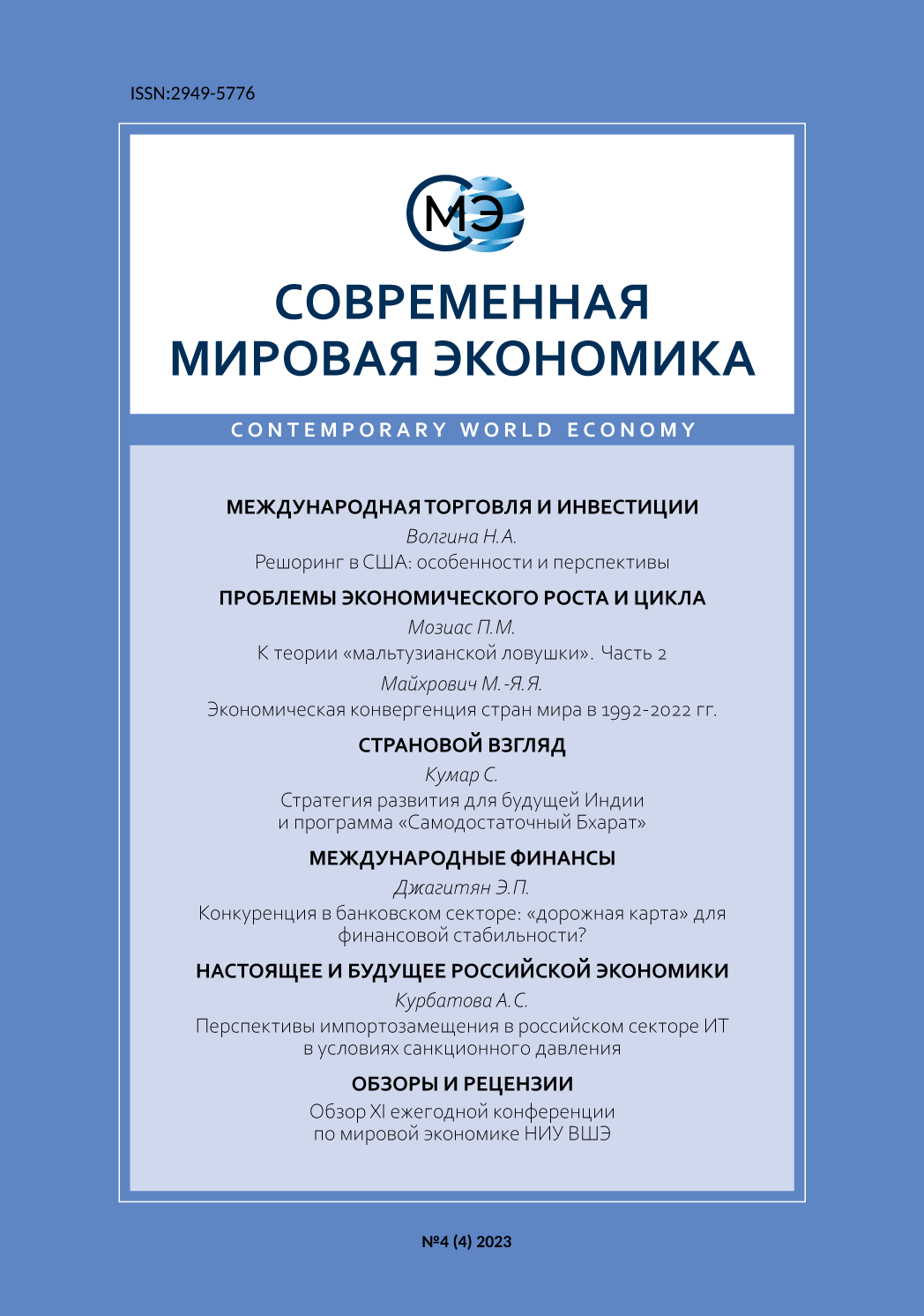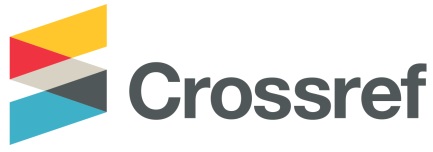Экономическая конвергенция стран мира в 1992–2022 гг.
Аннотация
В экономической науке всегда остро стоял вопрос об эффекте «наверстывания»: действительно ли развивающиеся страны догоняют технологически развитые, а экономический разрыв между богатыми и бедными странами сокращается в долгосрочной перспективе? Целью данной статьи является проверка гипотезы об экономической конвергенции стран как одной из главных исследовательских проблем в рамках тематики межстранового неравенства. Это исследование направлено также на более полное понимание факторов, определяющих экономическое межстрановое неравенство. В статье предпринимается попытка нахождения эффекта сближения стран, вытекающего из модели экономического роста Р. Солоу, с использованием уравнений Р. Барро для временнóго промежутка с 1992 по 2021/22 г. Выявлено наличие экономической конвергенции, но она слишком медленная для того, чтобы развивающиеся страны стали значимо догонять развитые. Отдельно проанализирована динамика конвергенции по десятилетиям. Выявлено, в частности, что в период с 2002 по 2011 г. конвергенция происходила максимально медленно, а в период с 2012 по 2022 г. — максимально быстро. Экономические шоки 2020–2022 гг. могут подорвать потенциал догоняющего развития многих развивающихся стран, в результате чего дальнейшая конвергенция может замедлиться.
Скачивания
Литература
Acemoglu, D., 2022. Cross-Country Inequality Trends. NBER Working Paper. No. 8832. P. 1-42.
Acemoglu, D., Robinson, J., 2012. Why Nations Fail: The Origins of Power, Prosperity, and Poverty. N.Y.: Crown Publishers.
Aslund, A., 2009. Baltic protests and financial meltdowns. Peterson Institute for International Economics. Available at: https://www.piie.com/commentary/op-eds/baltic-protests-and-financial-meltdowns
Attenborough, D., Lagarde, K., 2019. The Greatest Balancing Act. IMF. Finance & Development. P. 5.
Barro, R. J., 1999. Inequality and growth in a panel of countries. Journal of Economic Growth. Vol. 5. No. 1. P. 5-32.
Barro, R. J., 2016. Economic growth and convergence, applied especially to China. National Bureau of Economic Research. Working Paper 21872. P. 1-24.
Barro, R. J., Sala-i-Martin, X., 1992. Convergence. Journal of Political Economy. Vol. 100. No. 2. P. 223-251.
Barro, R. J., Sala-i-Martin, X., Blanchard, O. J., Hall, R. E., 1991. Convergence Across States and Regions. Brookings Papers on Economic Activity. Vol. 22. No. 1. P. 107-182.
Barro, R., 2013. Education and economic growth. Annals of Economics and Finance. Vol. 1. Issue 2. P. 301-328.
Barro, R.J., 2012. Convergence and modernization revisited. National Bureau of Economic Research. Working Paper 18295. P. 1-68.
Barro, R.J., Sala-i-Martin, X., 1990. Economic growth and convergence across the United States. National Bureau of Economic Research: Working Paper. No. 3419. P. 1-39.
Daly, K., Gedminas, T., 2022. The Path to 2075 – Slower Global Growth, But Convergence Remains Intact. Goldman Sachs. Global Economics Paper. P. 1-45.
Dementieva, A. A., 2021. Convergence theories in the history of economic science. Moscow Economic Journal. No 7. P. 506-516 (in Russian).
Diamond, J., 1997. Guns, Germs, and Steel: The Fates of Human Societies. W.W. Norton.
Franks, J., Barkbu, B., Blavy, R., Oman, W., Schoelermann, H., 2018. Economic Convergence in the Euro Area: Coming Together or Drifting Apart? IMF Working Paper. No. 10. P. 1-47.
Galor, O., 1996. Convergence? Inferences from theoretical models. Economic Journal. Vol. 106. Issue 437. P. 1056-1069.
Gasiorowski, M.T., 1995. Economic crisis and political regime change: An event history analysis. The American Political Science Review. Vol. 89. No. 4. P. 882-897.
Grigoryev, L. M., 2020. Global social drama of pandemic and recession. Population and Economics. No 4(2). P. 18-25.
Grigoryev, L. M., 2023. The Shocks of 2020-2023 and the Business Cycle. Contemporary World Economy. 2023. Vol. 1. No 1(1).
Grigoryev, L. M., Kurdin, A. A., Makarov, I. A. (eds), 2022. The World Economy in a Period of Big Shocks. Moscow: INFRA-M. (in Russian).
Grigoryev, L. M., Makarova, E. A.,2019. Capital accumulation and economic growth after the Great Recession. Voprosy Ekonomiki, No 12. P. 24-46 (in Russian).
Grigoryev, L. M., Maykhrovitch, M. Y., 2023. Growth theories: The realities of the last decades (Issues of sociocultural codes — to the expansion of the research program). Voprosy Ekonomiki. No 2. P. 18-42 (in Russian).
Grigoryev, L. M., Salmina, A.A., 2013. “Structure” of social inequality of the modern world: problems of measurement. Sociological Journal, No 3. P. 5-21 (in Russian).
IMF, 2019. Global Manufacturing Downturn, Rising Trade Barriers. Washington, DC: International Monetary Fund. Available at: https://www.imf.org/en/Publications/WEO/Issues/2021/01/26/2021-world-economic-outlook-update
IMF, 2021. World Economic Outlook: Policy Support and Vaccines Expected to Lift Activity. Washington, DC: International Monetary Fund. Available at: https://www.imf.org/en/Publications/WEO/Issues/2021/01/26/2021-world-economic-outlook-update
IMF, 2022. World Economic Outlook: Rising Caseloads, A Disrupted Recovery, and Higher Inflation. Washington, DC: International Monetary Fund. Available at: https://www.imf.org/en/Publications/WEO/Issues/2022/01/25/world-economic-outlook-update-january-2022
IMF, 2023. World Economic Outlook: Rising Caseloads, A Disrupted Recovery, and Higher Inflation. Washington, DC: International Monetary Fund. Available at: https://www.imf.org/en/Publications/WEO
IMF, 2020. World Economic Outlook: A Long and Difficult Ascent. Washington, DC: International Monetary Fund. Available at: https://www.imf.org/en/Publications/WEO/Issues/2021/01/26/2021-world-economic-outlook-update
Inglehart, R., Welzel, C., 2009. Modernization, Cultural Change, and Democracy: The Human Development Sequence. Cambridge University Press.
Jorda, V., Sarabia, J.M., 2015. International Convergence in Well-Being Indicators. Social Indicators Research. Vol. 120. No. 1. P. 1-27.
Kanellopoulos, K., Kousis, M., 2018. Protest, elections and austerity politics in Greece. In: Placas, A., Doxiadis, E. (eds). Living Under Austerity: Greek Society in Crisis. New York: Berghahn Press. P. 90-112.
Katada, S.N., 2013. Financial crisis fatigue? Politics behind Japan’s post-global financial crisis economic contraction. Japanese Journal of Political Science. Vol. 14. Issue 2. P. 223-242.
Kónya, L., Guisan, M. C., 2008. What does the human development index tell us about convergence? Applied Econometrics and International Development. No. 8. P. 19-40.
Lucas Jr., R., 2015. Human Capital and Growth. American Economic Review. Vol. 105. No. 5. P. 85-88.
Mazumdar, K., 2003. Do Standards of Living Converge? A Cross-country Study. Social Indicators Research. Vol. 64. P. 29-50.
Morozkina, A. K., Maichrovich, M.-Y. Y., Levina, V. A., 2024. Factors of vulnerability and resilience of developing countries during crises and their practical reflection on the example of shocks in 2020-2022 (in press).
Morozkina, A.K., 2019. Official Development Aid: Trends of the Last Decade. World Economy and International Relations. 2019. Vol. 63. No 9. P. 86-92 (in Russian).
Mozias, P. M., 2023. Russia in the BRICS Community: Choosing Priorities. Social and Humanities. Domestic and Foreign Literature. Series 9: Oriental Studies and African Studies. No 2. P. 37-66 (in Russian).
Nordhaus, W., 2017. Projections and uncertainties about climate change in an era of minimal climate policies. NBER Working Paper. No. 22933. P. 1-50.
Olafsson, S., 2016. Political turmoil in Iceland. Nordiques. No. 32. P. 29-42.
Paprotny, D., 2021. Convergence Between Developed and Developing Countries: A Centennial Perspective. Social Indicators Research. Vol. 153. P.193-225.
Podrugina, A. V., Lysenko, K. V., 2023. The Return of the World Economy to a High Inflation Regime. International Organisations Research Journal. Vol. 18. No 3.
Pritchett, L., 1997. Divergence, big time. Journal of Economic Perspectives. Vol. 11. No. 3. P. 3-17.
Rebello, J., Young, D. W., 2022. Global Growth to Slow through 2023, Adding to the Risk of ‘Hard Landing’ in Developing Economies. The World Bank press release No. 038.
Romer, P.M., 1990. Endogenous Technological Change. Journal of Political Economy. Vol. 98. No. 5. Part 2: The Problem of Development: A Conference of the Institute for the Study of Free Enterprise Systems. P. 71-102.
Samarasinghe, T., 2019. The relationship between institutions and economic development. MPRA Paper. No. 97755. P. 1-17.
Solarin, S.A., Erdogan, S., Pata, U.K., 2023. Convergence of Income Inequality in OECD Countries Since 1870: A Multi-Method Approach with Structural Changes. Social Indicators Research: An International and Interdisciplinary Journal for Quality-of-Life Measurement. Vol. 166. P. 601-626.
Solow, R.M., 1956. A Contribution to the Theory of Economic Growth. Quarterly Journal of Economics. Vol. 70. No. 1. P. 65-94.
World Bank (n.d.) World Development Indicators. Available at: https://databank.worldbank.org/source/world-development-indicators (date of access 20 March 2023).



.jpg)

